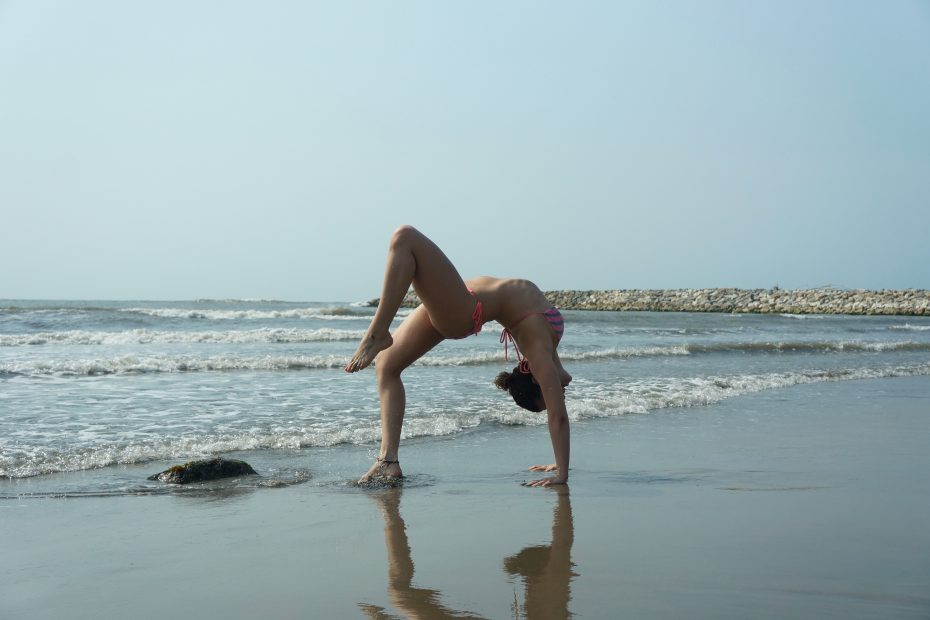At first glance, the asanas presented in the primary series of Ashtanga yoga can be intimidating to yogis still working to build strength, flexibility, and stamina. Some students will try the practice and decide it is too hard or they simply “can’t” do it. However, Ashtanga yoga does not require athleticism nor is strength the only physical or mental skill it cultivates in the practitioner. With emphasis on breath, flow, and the use of modifications, this style of yoga can open a new dimension for practitioners seeking a devotional and empowering asana system.
The Breath is the Core of the Practice
As in any yoga practice, it is really all about the breath. Ashtanga yoga is a vinyasa practice, so the emphasis here is on movement with the breath. The range of movement and form are less important in Ashtanga than the coordination of moving with the breath. Generally, you inhale when coming forward or up and when opening the front of the body and exhale when folding or moving back.
Ashtanga yoga also utilizes ujjayi breathing, which some yogis translate as “the victorious breath.” Mastering this type of breathing and keeping your awareness focused on it is a challenge all in itself and should be the focus of the practice, not the asanas.
Ujjayi breathing is a strong and full type of breathing, but implies that the bandha area of the pelvis and upper abdomen are engaged. These are referred to as Mulabandha and Uddiyanabandha. It is not a tightening of the abdominal muscles that accomplishes this, but a lifting of the inner core of the body, an incredibly subtle sensation.
The effect of Ujjayi breathing is that movement of the middle and upper chest are deep and exaggerated. The diaphragm is still expanding and the lower lungs are filled and emptied, but the low belly stays still. This helps you develop the core stability to progress in the physical aspects of the Ashtanga asana series.
Essentially, regardless of what poses you do or don’t do in the series, you are a more successful practitioner of Ashtanga yoga if you can keep the mind focused on the breath, the movement married to the breath, and the bandha areas engaged. Even the most strong and agile yogi will tell you they have never made it through a practice without missing a breath or letting the mind wander. This is the true practice, and it is just that: a practice. There is no yoga performance and no need for perfection, only the desire to work towards it.
The Benefits of Learning of Set Series of Asanas
Ashtanga yoga offers a set series of asanas in its prescribed hatha practice. The sun salutations, standing sequence, and closing sequence are always the same, regardless of whether you are studying the primary, intermediate, or more advanced group of series.
One potential aspect of such a practice is monotony, but another is that it gives a yoga practitioner the opportunity to cultivate a self-practice that eliminates the internal question of “what do I do now?”
Occasionally, yoga without the guidance of a teacher can be challenging for a student. It is hard to stay self-motivated or to create sequences for oneself. In Ashtanga yoga, learning the sequence is part of the practice. Committing to follow the sequence, which is a time-honored and tested full-body practice, empowers the student to create their own personal practice. He knows what is coming and it is his own breath that leads the flow of the practice.
Furthermore, one’s own modifications become part of his own practice, giving one the opportunity to explore his own inner wisdom, his “guru haridya manas,” or inner teacher. Choosing strength of breath over strength of body, or length of spine over depth of twist are opportunities to soothe and nourish the body rather than push and brutalize it.
Ashtanga Yoga as a Moving Meditation
Once the sequence is ingrained in the practitioner’s memory, there is no worry about what comes next or how to do it. This freedom opens the door for moving meditation and is ideal for those seeking a meditative state that have not had success with more sedentary approaches.
Letting the breath fill not only the body, but also the mind, takes one out of the state of being in which we live the majority of our lives and into the present moment. One is literally with the breath, not only in movement, but in all aspects.
Feel Good Yoga
If there is soreness or a feeling of misalignment after an Ashtanga yoga practice, this is a sure sign one is moving too fast and pushing too hard. As in many other hatha yoga practices, the focus is on achieving the poses in an anatomically correct and balanced way. The body should feel better for having practiced, not worse. If there is pain, slow down. Focus on awareness of the body in space, proper alignment, and relaxation where possible.
Ultimately, any hatha yoga is designed to improve and condition the physical aspects of our being. Yoga practitioners acknowledge that overall well-being encompasses the physical self. As long as this intention leads the practice, any yoga is good yoga.
